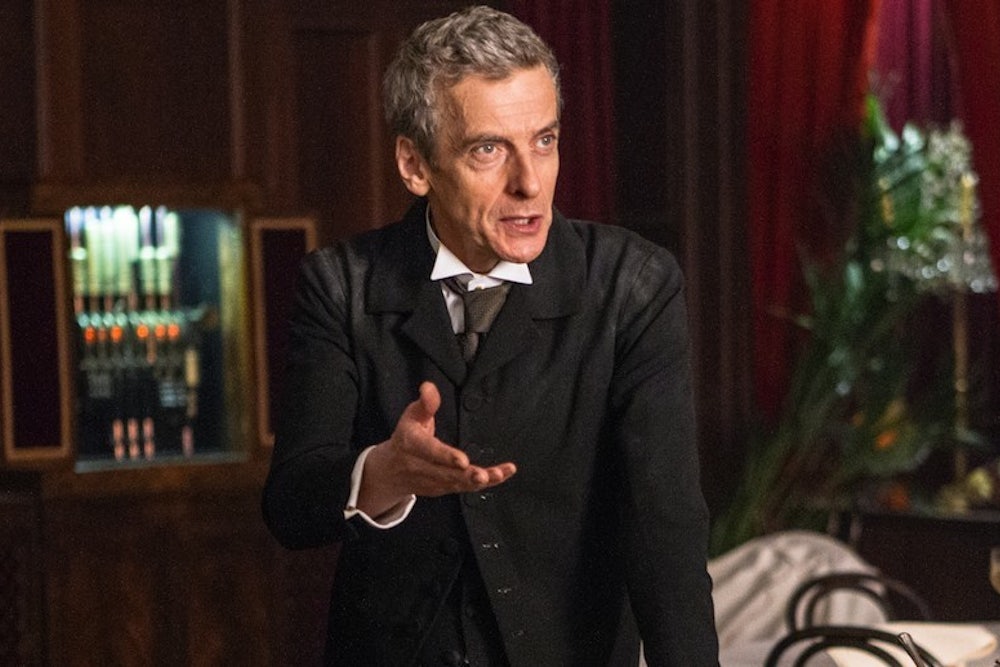“Doctor Who” returned last Saturday with a new leading man, Peter Capaldi, as the twelfth incarnation of the time-traveling alien. The British classic has always relied on the concept of “regeneration,” the clever gimmick that the Doctor can take on a new body—which means a new actor—whenever the old one is wounded or worn out. It’s what sustained the show for over 50 years, but every change brings its hiccups.
And this transition—from young, handsome Matt Smith to the 56-year-old Capaldi—brings more than most. When Capaldi was first unveiled last August, it sparked an Internet debate over whether or not he was too old, with Tweets like: “#doctorwho The new doctor who is some old guy. what the heck. I am not watching the program anymore. HE HAS GREY HAIR.” Capaldi himself, a lifelong fan who, at 14, demanded to be made fan club president, confessed he didn’t believe he would be cast because of his age. Fans weren’t the only ones concerned about how to handle the show’s oldest Doctor ever. The season premiere focused on the Doctor’s companion, Clara Oswald, who had her own difficulty coping with the Doctor’s new, older appearance. The companions—usually women who accompany the Doctor on his missions—have always been the proxy for the audience, and last week we were unequivocally told that no, the Doctor is not our boyfriend. Yes, he is old now, and no, he will not be our dashing gentleman friend. If we can’t accept that, then we, like Clara, are not true fans. It’s a bold move, one that not only tests the show’s popularity here in the U.S., but also marks a crossroads for the mainstream success of nerd culture.
The ascent of things once considered nerdy is plain to see. Comic book superheroes, once the province of awkward adolescent boys, are everywhere, and kids are growing up wanting to be Sherlock Holmes and Peter Parker. This month, Marvel’s Guardians of the Galaxy made $94.3 million in North America on its opening weekend, the top August debut of all time. Later this year, biopics about scientists Stephen Hawking and Alan Turing are expected to garner Oscar attention. The American audience for “Doctor Who” has grown from 910,000 in 2010—Matt Smith’s first season—to 1.9 million in his last.
The mainstream popularity of nerd culture may be a recent development, but the formula these successes are built on definitely isn’t. Propping up these franchises are impossibly buff, good-looking young actors like Andrew Garfield, Chris Hemsworth, Chris Evans, and Michael Fassbender. Guardians of the Galaxy star Chris Pratt lost 60 pounds, gave up beer for six months, and kept a strict, much-publicized diet to play the gun-slinging superhero Star Lord. Even the brainiest of them all, Sherlock Holmes, has been given an action hero update on the silver screen, with Robert Downey Jr. in the title role, while Benedict Cumberbatch, who plays the famous detective on a popular BBC show, commands legions of fans, self-styled “Cumberbitches.” While Hollywood primarily targets the young male demographic, the good-looking stars have helped catapult these formerly niche features to the top of the box office, as men and women alike flock to see them.
“Doctor Who” was no different. Since its revival in 2005, the BBC show has stayed away from its traditional lineup of older, fatherly Doctors and cast young, good-looking actors full of energy. Character actor Christopher Eccleston, portraying the Ninth Doctor, didn’t quite fit the formula of romantic leading man—he was 40 at the time—but he barely lasted a year in the role. It was only with David Tennant, known at that point for his Shakespearean performances and for a TV adaptation of Casanova, that the show really took off. Both Tennant and Matt Smith brought an almost manic energy, bouncing all over the screen and talking even faster than they moved. Tennant’s Doctor was known as a tragic, romantic figure, while Smith embraced a childlike wonder and lovable silliness as his defining characteristics.
And it wasn’t just the actors; the storyline was constructed around their potential as romantic leading men. Tennant’s Doctor seemed to have women swooning over him wherever he went in time and space, and much of his arc was built around his star-crossed love with his first companion, Rose. Not to be outdone, Smith’s Doctor gets married twice (once to Marilyn Monroe, no less) and has to fend off the advances of his own companion, Amy Pond, who runs away with him on the eve of her own wedding. “Doctor Who” fansites and tumblrs are filled with sketches, collages, and fan fictions about the Doctor’s many romantic relationships. Fans recently held the “Fangirl Challenge 2014,” where they received the name of a “Doctor Who” couple and were tasked with creating tributes to them. Another fan blogged at length about how the relationship between the eleventh Doctor and his wife drew her to the show.
Now, with Capaldi, who has sworn that there will be “no flirting,” the new iteration of “Doctor Who” faces a test. If it can sustain its popularity, or even grow, it would mean that the “Doctor Who” brand is powerful enough to appeal to a broad audience without the help of romance and sex appeal. So far, it’s rising to the challenge: Last week’s premiere brought in a 2.2 million American viewers, a new record.
